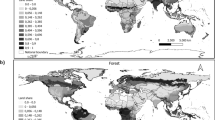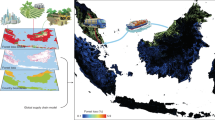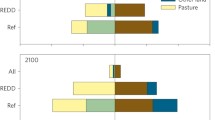Abstract
The extensive clearing of tropical forests throughout past decades has been partly assigned to increased trade in agricultural goods. Since further trade liberalisation can be expected, remaining rainforests are likely to face additional threats with negative implications for climate mitigation and the local environment. We apply a spatially explicit economic land-use model coupled to a biophysical vegetation model to examine linkages and associated policies between trade and tropical deforestation in the future. Results indicate that further trade liberalisation leads to an expansion of deforestation in Amazonia due to comparative advantages of agriculture in South America. Globally, between 30 and 60 million ha (5–10 %) of tropical rainforests would be cleared additionally, leading to 20–40 Gt additional \(\hbox {CO}_{2}\) emissions by 2050. By applying different forest protection policies, those values could be reduced substantially. Most effective would be the inclusion of avoided deforestation into a global emissions trading scheme. Carbon prices corresponding to the concentration target of 550 ppm would prevent deforestation after 2020. Investing in agricultural productivity reduces pressure on tropical forests without the necessity of direct protection. In general, additional trade-induced demand from developed and emerging countries should be compensated by international efforts to protect natural resources in tropical regions.









Similar content being viewed by others
Notes
The Doha Development Round is the latest round of trade negotiations of the World Trade Organisation (WTO). It was launched in 2011 with the aim of improving the access to global markets. For more information on the stage and agenda of the Doha Round, see Martin and Mattoo (2011).
References
Angelsen A, Kaimowitz D (2001) Introduction: the role of agricultural technologies in tropical deforestation. In: Angelsen A, Kaimowitz D (eds) Introduction: the role of agricultural technologies in tropical deforestation. CABI, Oxon
Angelsen A (2010) Policies for reduced deforestation and their impact on agricultural production. Proc Natl Acad Sci 107(46):19639–19644. doi:10.1073/pnas.0912014107
Banerjee O, MacPherson AJ, Alavalapati J (2009) Toward a policy of sustainable forest management in Brazil: a historical analysis. J Environ Dev 18(2):130–153. doi:10.1177/1070496509333567
Barbier EB (2000) Links between economic liberalization and rural resource degradation in the developing regions. Agric Econ 23(3):299–310. doi:10.1016/S0169-5150(00)00091-8
Barraclough S, Ghimire K (2000) Agricultural expansion and tropical deforestation. Earthscan, London
Beresford AE, Eshiamwata GW, Donald PF, Balmford A, Bertzky B, Brink AB, Fishpool LDC, Mayaux P, Phalan B, Simonetti D, Buchanan GM (2013) Protection reduces loss of natural land-cover at sites of conservation importance across Africa. PLoS One 8(5):e65370. doi:10.1371/journal.pone.0065370
Bondeau A, Smith P, Zaehle S, Schaphoff S, Cramer W, Gerten D, Lotze-Campen H, Müller C, Reichstein M, Smith B (2007) Modelling the role of agriculture for the 20th century global terrestrial carbon balance. Glob Change Biol 13(3):679–706. doi:10.1111/j.1365-2486.2006.01305.x
Bradshaw CJA, Sodhi NS, Peh K, Brook BW (2007) Global evidence that deforestation amplifies flood risk and severity in the developing world. Glob Change Biol 13(11):2379–2395. doi:10.1111/j.1365-2486.2007.01446.x
Bryant D, Nielsen D, Tangley L (1997) The last frontier forests—ecosystems and economies on the edge. World Resources Institute (WRI), Washington
Byerlee D, Stevenson J, Villoria N (2014) Does intensification slow crop land expansion or encourage deforestation? Glob Food Sec 3(2):92–98. doi:10.1016/j.gfs.2014.04.001
Conforti P, Salvatici L (2004) Agricultural trade liberalisation in the Doha round—alternative scenarios and strategic interactions between developed and developing countries. FAO Commodity and Trade Policy Research Working Paper 10
Costa MH, Foley JA (2000) Combined effects of deforestation and doubled atmospheric CO2 concentrations on the climate of Amazonia. J Clim 13:18–34. doi:10.1175/1520-0442(2000)0130018:CEODAD
DeFries RS, Rudel T, Uriarte M, Hansen M (2010) Deforestation driven by urban population growth and agricultural trade in the twenty-first century. Nat Geosci 3:178–181. doi:10.1038/NGEO756
Dollar D, Kraay A (2004) Trade, growth and poverty. Econ J 114:22–49. doi:10.1111/j.0013-0133.2004.00186.x
Dietrich JP, Schmitz C, Müller C, Fader M, Lotze-Campen H, Popp A (2012) Measuring agricultural land-use intensity—a global analysis using a model-assisted approach. Ecol Model 232:109–118. doi:10.1016/j.ecolmodel.2012.03.002
Dietrich JP, Schmitz C, Lotze-Campen H, Popp A, Müller C (2013) Forecasting technological change in agriculture—an endogenous implementation in a global land use model. Technol Forecast Soc Change. doi:10.1016/j.techfore.2013.02.003
Eickhout B, van Meijl H, Tabeau A, Stehfest E (2010) The impact of environmental and climate constraints on global food supply. In: Hertel TW, Rose SK, Tol RSJ (eds) Economic analysis of land use in global climate change policy. Routledge, New York
Erb K-H, Gaube V, Krausmann F, Plutzar C, Bondeau A, Haberl H (2007) A comprehensive global 5 min resolution land-use data set for the year 2000 consistent with national census data. J Land Use Sci 2(3):191–224. doi:10.1080/17474230701622981
Fader M, Rost S, Müller C, Bondeau A, Gerten D (2010) Virtual water content of temperate cereals and maize: present and potential future patterns. J Hydrol 384(3–4):218–231. doi:10.1016/j.jhydro1.2009.12.011
FAO (2010) Global forest resources assessment 2010, main report, Food and Agriculture Organization of the United Nations. FAO Forestry Paper 163, Rome
FAO (2011a) FAOSTAT—Food and Agriculture Organization of the United Nations Statistics Division. http://faostat.fao.org/. Last access: 12/10/2011
FAO (2011b) State of the world’s forests 2011. Food and Agriculture Organization of the United Nations, Rome
Fearnside PM, Laurance WF (2003) Comment on “Determination of deforestation rates of the world’s humid tropical forests”. Science 299:1015. doi:10.1126/science.1078714
Fearnside PM (2005) Deforestation in Brazilian Amazonia: history, rates, and consequences. Conserv Biol 19(3):680–688. doi:10.1111/j.1523-1739.2005.00697.x
Feenstra RC (1998) Integration of trade and disintegration of production in the global economy. J Econ Perspect 12(4):31–50. doi:10.1257/jep.12.4.31
Forner C, Blaser J, Jotzo F, Robledo C (2005) Keeping the forest for the climate’s sake: avoiding deforestation in developing countries under the UNFCCC. Clim Policy 6(3):275–294. doi:10.1080/14693062.2006.9685602
Gibbs HK, Johnston M, Foley JA, Holloway T, Monfreda C, Ramankutty N, Zaks D (2008) Carbon payback times for crop-based biofuel expansion in the tropics: the effects of changing yield and technology. Environ Res Lett 3:034001. doi:10.1088/1748-9326/3/3/034001
Gibbs HK, Ruesch AS, Achard F, Clayton MK, Holmgren P, Ramankutty N, Foley JA (2010) Tropical forests were the primary sources of new agricultural land in the 1980s and 1990s. Proc Natl Acad Sci 107(38):16732–16737. doi:10.1073/pnas.0910275107
Gorenflo LJ, Brandon K (2005) Agricultural capacity and conservation in high biodiversity forest ecosystems. AMBIO 34(3):199–204. doi:10.1579/0044-7447-34.3.199
Hertel TW (2012) Implications of agricultural productivity for global cropland use and GHG emissions: Borlaug vs. Jevons. GTAP working paper 69
Heston A, Summers R, Aten B (2011) Penn World Table Version 7.0. Center for International Comparisons of Production, Income and Prices at the University of Pennsylvania, May 2011
Hosonuma N, Herold M, De Sy V, De Fries RS, Brockhaus M, Verchot L, Angelsen A, Romijn E (2012) An assessment of deforestation and forest degradation drivers in developing countries. Environ Res Lett 7(4):004009. doi:10.1088/1748-9326/7/4/044009
Houghton RA (2003) Revised estimates of the annual net flux of carbon to the atmosphere from changes in land use and land management 1850–2000. Tellus B 55(2):378–390. doi:10.1034/j.1600-0889.2003.01450.x
IPCC (2007) Climate change 2007: mitigation. In: Metz B, Davidson OR, Bosch PR, Dave R, Meyer LA (eds) Contribution of working group III to the fourth assessment report of the Intergovernmental Panel on Climate Change. Cambridge University Press
Jacks DS, Meissner CM, Novy D (2008) Trade costs 1870–2000. Am Econ Rev 98(2):529–534. doi:10.1257/aer.98.2.529
Josling T (2010) Looking ahead to 2050—evolution of agricultural trade policies. In: Sarris A, Morrison J (eds) The evolving structure of world agricultural trade: implications for trade policy and trade agreements. FAO, Rome
Kauppi PE, Ausubel JH, Fang J, Mather AS, Sedjo RA, Waggoner PE (2006) Returning forests analyzed with the forest identity. Proc Natl Acad Sci 103(46):17574–17579. doi:10.1073/pnas.0608343103
Kindermann G, Obersteiner M, Sohngen B, Sathaye J, Andrasko K, Rametsteiner E, Schlamadinger B, Wunder S, Beach R (2008) Global cost estimates of reducing carbon emissions through avoided deforestation. Proc Natl Acad Sci 105(30):10302–10307. doi:10.1073/pnas.0710616105
Kolstad C, Urama K, Broome J, Bruvoll A, Olvera MC, Fullerton D, Gollier C, Hanemann WM, Hassan R, Jotzo F, Khan MR, Meyer L, Mundaca L, Aghion P, Allcott H, Betz G, Borenstein S, Brennan A, Caney S, Farber D, Jaffe A, Luderer G, Ockenfels A, Popp A (2008) Social, economic and ethical concepts and methods. In: IPCC (ed) Climate change 2014: mitigation of climate change
Krause M, Lotze-Campen H, Popp A (2009) Spatially-explicit scenarios on global cropland expansion and available forest land in an integrated modelling framework. Selected and reviewed paper at the 27th IAAE conference in Beijing, China, Aug 16–22
Krause M, Lotze-Campen H, Popp A, Dietrich JP, Bonsch M (2012) Conservation of undisturbed natural forests and economic impacts on agriculture. Land Use Policy 30:344–354. doi:10.1016/j.landusepol.2012.03.020
Lamb D (2011) Regreening the bare hills—tropical forest restoration in the Asia-Pacific region. World Forests VIII, Springer. doi:10.1007/s10745-011-9436-5
Lambin EF, Turner BL, Geist HJ, Agbola SB, Angelsen A, Bruce JW, Coomes OT, Dirzo R, Fischer G, Folke C, George PS, Homewood K, Imbernon J, Leemans R, Li X, Moran EF, Mortimore M, Ramakrishnan PS, Richards JF, Skanes H, Steffen W, Stone GD, Svedin U, Veldkamp TA, Vogel C, Xu J (2010) The causes of land-use and land-cover change: moving beyond the myths. Glob Environ Change 11(4):261–269. doi:10.1016/S0959-3780(01)00007-3
Lazdins A, von Hofsten H, Dagnija L, Lazdans V (2008) Productivity and costs of stump harvesting for bioenergy production in Latvian conditions. Eng Rural Dev 2009:194–201
Lotze-Campen H, Müller C, Bondeau A, Jachner A, Popp A, Lucht W (2008) Global food demand, productivity growth, and the scarcity of land and water resources: a spatially explicit mathematical programming approach. Agric Econ 39:325–338. doi:10.1111/j.1574-0862.2008.00336.x
Lotze-Campen H, Popp A, Beringer T, Müller C, Bondeau A, Rost S, Lucht W (2010) Scenarios of global bioenergy production: the trade-offs between agricultural expansion, intensification and trade. Ecol Model 221:2188–2196. doi:10.1016/j.ecolmodel.2009.10.002
Luderer G, Pietzcker R, Kriegler E, Haller M, Bauer N (2012) Asia’s role in mitigating climate change: a technology and sector specific analysis with ReMIND-R. Energy Econ (under review). doi:10.1016/j.eneco.2012.07.022
Martin W, Mattoo A (2011) Unfinished business? The WTO’s Doha agenda. World Bank Report in cooperation with the Centre for Econmic Policy Research, Washington DC. http://go.worldbank.org/S9GA0D7RY0
Merry FD, Hildebrand PE, Pattie P, Carter DR (2002) An analysis of land conversion from sustainable forestry to pasture: a case study in the Bolivian Lowlands. Land Use Policy 19:207–215. doi:10.1016/S0264-8377(02)00015-7
Meyfroidt P, Rudel TK, Lambin EF (2010) Forest transitions, trade, and the global displacement of land use. Proc Natl Acad Sci 107(49):20917–20922. doi:10.1073/pnas.1014773107
Meyfroidt P, Lambin EF (2011) Global forest transitions: prospects for an end to deforestation. Annu Rev Environ Resour 36:343–371. doi:10.1146/annurev-environ-090710-143732
Morton DC, DeFries RS, Shimabukuro VE, Anderson LO, Arai E, Espirito-Santo F, Freitas R, Morisette J (2006) Cropland expansion changes deforestation dynamics in the southern Brazilian Amazon. Proc Natl Acad Sci 103(39):14637–14641. doi:10.1073/pnas.0606377103
Narayanan B, Walmsley TL (2008) Global trade, assistance, and production: the GTAP 7 data base. Center for Global Trade Analysis, Purdue University
Nelson A (2008) Estimated travel time to the nearest city of 50,000 or more people in year 2000. Global Environment Monitoring Unit—Joint Research Centre of the European Commission, Ispra Italy. http://bioval.jrc.ec.europa.eu/products/gam/. Accessed 30/07/2011
Nelson A, Chomitz KM (2011) Effectiveness of strict vs. multiple use protected areas in reducing tropical forest fires: a global analysis using matching methods. PLoS One 6(8):e22722. doi:10.1371/journal.pone.0022722
Nepstad DC, Stickler CM, Almeida OT (2006) Globalization of the Amazon soy and beef industries: opportunities for conservation. Conserv Biol 20(6):1595–1603. doi:10.1111/j.1523-1739.2006.00510.x
Nepstad D, Soares-Filho BS, Merry F, Lima A, Moutinho P, Carter J, Bowman M, Cattaneo A, Rodrigues H, Schwartzman S, McGrath DG, Stickler CM, Lubowski R, Piris-Cabezas P, Rivero S, Alencar A, Almeida O, Stella O (2009) The end of deforestation in the Brazilian Amazon. Science 326(5958):1350–1351. doi:10.1126/science.1182108
Pan J, Birdsey RA, Fang J, Houghton R, Kauppi PE, Kurz WA, Philips OL, Shvidenko A, Lewis SL, Canadell JG, Ciais P, Jackson RB, Pacala SW, McCuire AD, Piao S, Rautiainen A, Sitch S, Hayes D (2011) A large and persistent carbon sink in the world’s forests. Science 333(6045):988–993. doi:10.1126/science.1201609
Parker C, Mitchell A, Trivedi M, Mardas N, Sosis K (2009) The Little REDD+ Book—an updated guide to governmental and non-governmental proposals for reducing emissions from deforestation and degradation. Global Canopy Programme, Oxford
Peters-Stanley M, Gonzalez G (2014) Sharing the stage. State of the Voluntary Carbon Markets 2014. Forest Trends Ecosystem Marketplace 1
Popp A, Lotze-Campen H, Bodirsky B (2010) Food consumption, diet shifts and associated non-CO2 greenhouse gases from agricultural production. Glob Environ Change 20:451–462. doi:10.1016/j.gloenvcha.2010.02.001
Popp A, Dietrich JP, Lotze-Campen H, Klein D, Bauer N, Krause M, Beringer T, Gerten D, Edenhofer O (2011) The economic potential of bioenergy for climate change mitigation with special attention given to implications for the land system. Environ Res Lett 6(3):034017. doi:10.1088/1748-9326/6/3/034017
Popp A, Krause M, Dietrich JP, Lotze-Campen H, Leimbach M, Beringer T, Bauer N (2012) Additional CO2 emissions from land use change—forest conservation as a precondition for sustainable production of second generation bioenergy. Ecol Econ 74:64–70. doi:10.1016/j.ecolecon.2011.11.004
Potapov P, Yaroshenko A, Turubanova S, Dubinin M, Laestadius L, Thies C, Aksenov D, Egorov A, Yesipova Y, Glushkov I, Karpachevskiy M, Kostikova A, Manisha A, Tsybikova E, Zhuravleva I (2008) Mapping the world’s intact forest landscapes by remote sensing. Ecol Soc 13(2):1–16
Ramankutty N, Gibbs HK, Archard F, deFries R, Foley JA, Houghton RA (2006) Challenges to estimating carbon emissions from tropical deforestation. Glob Change Biol 13(1):51–66. doi:10.1111/j.1365-2486.2006.01272.x
Rost S, Gerten D, Bondeau A, Lucht W, Rohwer J, Schaphoff S (2008) Agricultural green and blue water consumption and its influence on the global water system. Water Resour Res 44:W09405. doi:10.1029/2007WR006331
Schmitz C, Biewald A, Lotze-Campen H, Popp A, Dietrich JP, Bodirsky B, Krause M, Weindl I (2012) Trading more food—implications for land use, greenhouse gas emissions and the food system. Glob Environ Change 22(1):189–209. doi:10.1016/j.gloenvcha.2011.09.013
Simmons IG (1987) Transformation of the land in pre-industrial time. In: Wolman MG, Fournier FGA (eds) Land transformation in agriculture. Wiley, Chichester, pp 45–77
Simorangkir D (2007) Fire use: is it really the cheaper land preparation method for large-scale plantations? Mitig Adapt Strateg Glob Change 12:147–164. doi:10.1007/s11027-006-9049-2
Soares-Filho BS, Nepstad DC, Curran LM, Cerqueira GC, Garcia RA, Ramos CA, Voll E, McDonald A, Lefebvre R, Schlesinger P (2006) Modelling conservation in the Amazon basin. Nature 440:520–523. doi:10.1038/nature04389
Soares-Filho BS, Moutinho P, Nepstad DC, Anderson A, Rodrigues H, Garcia RA, Dietzsch L, Merry F, Bowman M, Hissa L, Silvestrini R, Maretti C (2010) Role of Brazilian Amazon protected areas in climate change mitigation. Proc Natl Acad Sci 107(24):10821–10826. doi:10.1073/pnas.0913048107
Sohngen B, Tennity C, Hnytka M (2009) Global forestry data for the economic modeling of land use. In: Hertel TW, Rose S, Tol RSJ (eds) Economic analysis of and use in global climate change policy. Routledge, New York, pp 49–71
Thomson AM, Calvin KV, Chini LP, Hurtt G, Edmonds JA, Bond-Lamberty B, Frolking S, Wise MA, Janetos AC (2010) Climate mitigation and the future of tropical landscapes. Proc Natl Acad Sci 107(46):19633–19638. doi:10.1073/pnas.0910467107
UN (2011) World population prospects: the 2010 revision. United Nations, Department of Economic and Social Affairs, Population Division, CD-ROM edition
UNEP-WCMC (United Nations Environment Programme World Conservation Monitoring Centre) (2006) World Database on Protected Areas (WDPA), CD-ROM, Cambridge, UK. http://sea.unep-wcmc.org/wdbpa/
van Meijl H, van Rheenen T, Tabeau A, Eickhout B (2006) The impact of different policy environments on agricultural land use in Europe. Agric Ecosyst Environ 114:21–38. doi:10.1016/j.agee.2005.11.006
van Velthuizen H, Huddleston B, Fischer G, Salvatore M, Ataman E, Nachtergaele FO, Zanetti M, Bloise M, Antonicelli A, Bel J, De Liddo A, De Salvo P, Franceschini G (2007) Mapping biophysical factors that influence agricultural production and rural vulnerability. Environment and Natural Resources Series, 11, FAO, Rome
van der Werf GR, Morton DC, DeFries RS, Olivier JGJ, Kasibhatla PS, Jackson RB, Collatz GJ, Randerson JT (2009) \(\text{CO}_{2}\) emissions from forest loss. Nat Geosci 2(11):737–738. doi:10.1038/ngeo671
Verburg R, Stehfest E, Woltjer G, Eickhout B (2009) The effect of agricultural trade liberalisation on land-use related greenhouse gas emissions. Glob Environ Change 19:434–446. doi:10.1016/j.gloenvcha.2009.06.004
Wise M, Calvin K, Thomson A, Clarke L, Bond-Lamberty B, Sands R, Smith SJ, Janetos A, Edmonds J (2009) Implications of limiting CO2 concentrations for land use and energy. Science 324:1183–1186. doi:10.1126/science.1168475
Würtenberger L, Koellner T, Binder CR (2007) Virtual land use and agricultural trade: estimating environmental and socio-economic impacts. Ecol Econ 57(4):679–697. doi:10.1016/j.ecolecon.2005.06.004
Wunder S (2008) How do we deal with leakage? In: Angelsen A (ed) Moving ahead with REDD: issues, options and implications. CFIOR, Bogor, pp 65–75
Acknowledgments
We thank our colleagues in the land-use research group of PIK for many valuable discussions. We gratefully acknowledge financial support by the German BMBF projects “Hydrothermal carbonisation of biomass” and “GLUES Global Assessment of Land Use Dynamics on Greenhouse Gas Emissions and Ecosystem Services” and the EU FP7 project “Visions of Land Use Transitions in Europe (VOLANTE)”. Finally, we thank Alison Schlums for proofreading. The authors declare that there is no conflict of interest.
Author information
Authors and Affiliations
Corresponding author
Additional information
Editor: Will Steffen.
Rights and permissions
About this article
Cite this article
Schmitz, C., Kreidenweis, U., Lotze-Campen, H. et al. Agricultural trade and tropical deforestation: interactions and related policy options. Reg Environ Change 15, 1757–1772 (2015). https://doi.org/10.1007/s10113-014-0700-2
Received:
Accepted:
Published:
Issue Date:
DOI: https://doi.org/10.1007/s10113-014-0700-2




